Wiltipoll ewe joining and lambing management on Moffitts Farm
By Patrick Francis
On Moffitts Farm near Romsey in the Macedon Ranges Shire we aim to record as much information as possible about our Wiltipoll flock, paddock carrying capacity, soil health and farm biodiversity.
Our flock breeding program is based around a number of ewe and ram strategies. These include:
- Ensuring ewe condition scores are at least three at joining and 3.5 to 4 at lambing.
- By employing year round green perennial grasses in our pastures, we use rotational grazing to help ensure ewes are on a rising plane of nutrition prior to and during joining. Every summer some thunderstorms occur which ensures the year round green perennials are growing green feed. Even in the last two summers when thunderstorms were few and far between we were able to grow green feed in all paddocks. It doesn’t have to be a large quantity of green feed to provide a “rising plane of nutrition” during joining in March-April.
- Three weeks prior to joining in mid- March we utilise the “ram effect” to help stimulate ewes to come on-heat (oestrus). We do this by running rams in a paddock adjacent to the ewes. The ram effect was used for the first time in 2015 as a strategy to reduce the number of weeks ewes lamb over. While joining is restricted to five weeks (the time the rams are in with the ewes), it is better if all lambs are born in three weeks. In 2015, the “ram effect” produced 90% of lambs born in three weeks. In 2016 the impact was even better with 98% born in three weeks.
Since 2016 the ram effect has continued to ensure a tight lambing with an average over the years of 95% lambs born in the first three weeks of the five week lambing period.
- The shorter the lambing period, the narrower is the range of weaning and lamb selling weights; this is a help when marketing lambs. As well, in our flock management, the shorter the lambing period the better as we drift lamb, that is, as ewes lamb they are shifted out of the lambing paddock into a separate “lambed ewe” flock within about 18 hours of birth. While this is an intensive method it ensures we know exactly about the status of all lambs born and can manage the ewes accordingly. If a lamb dies at or after birth we have a better understanding of why.
- We record all lamb birth weights and status as singles, twins or triplets.If special attention is needed, for example with low birth weight twins or triplets, this can be provided. Because we are lambing from 8 August on, weather conditions are at their worst, with daytime temperature ranging between 5 and 8C. Strong northerly or south westerly winds can produce wind chills between 0 and 4C. Wind chill has been calculated for cooler regions around Victoria. Hamilton has a high number of days per month with bad wind chill and the worst months are July and August, Figure 1. Romsey is similar to Ballarat which has a higher number of bad chill days in August than Hamilton.
- Figure 1: Bad wind chill days are highest in July and August.
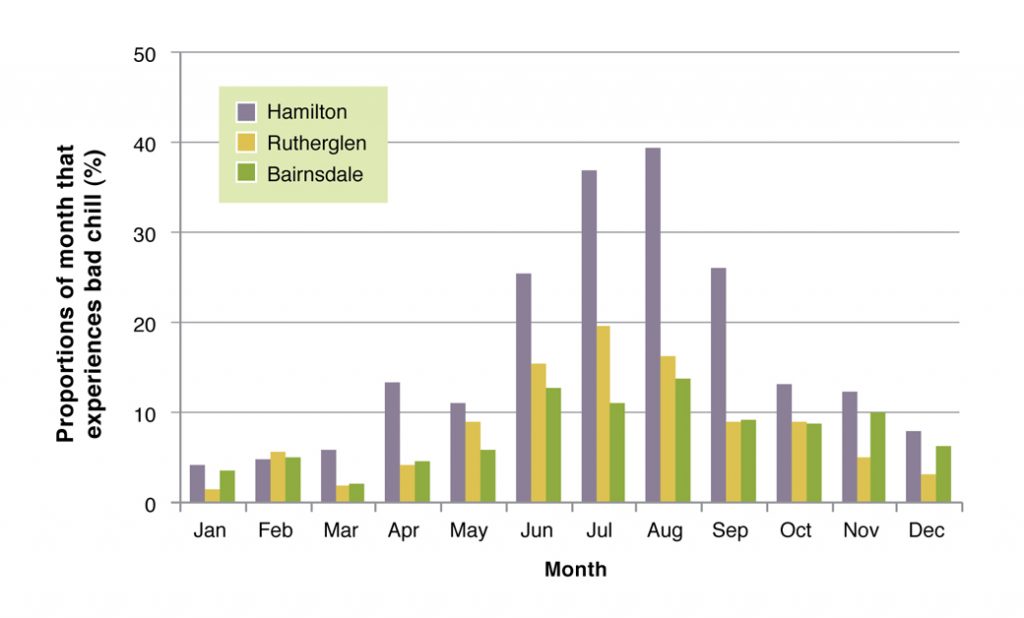
- On bad chill days mortality rate of new born lambs can be extreme especially if there is no protection from the wind, as happens on many farms due to lack of pasture ground cover figure 2 . On Moffitts Farm we have measured wind speed at 8 cm above the surface in 30 cm high pasture, it is reduced to zero. This means lambs are being protected by the pasture from the bad impacts of wind chill despite the fact the air temperature is low. With our tall pastures there have been no lamb mortalities due to extreme cold weather.
- Figure 2: Lamb mortality rates can be extreme for unprotected lambs on bad wind chill days.
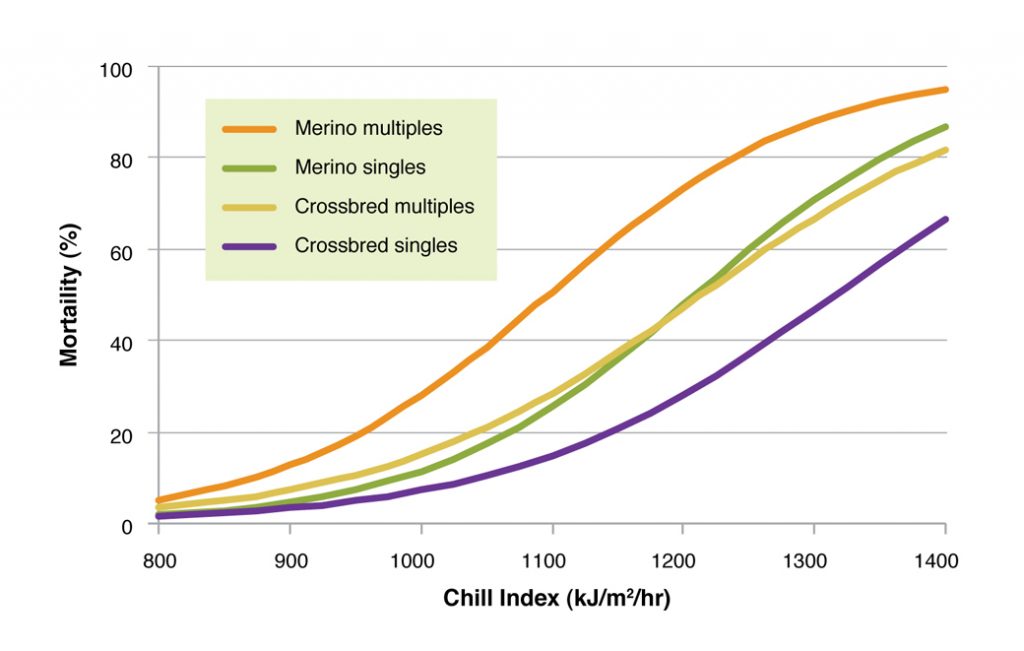
- Finally, drift lambing enables us to record ewe Maternal Behaviour Scores. This scoring system was devised in New Zealand and is a means to select ewes with the strongest mothering instinct. Put another way, it selects ewes which are not stressed by the presence of humans. We score MBS 1 to 5, with 5 being a ewe which runs away from her lambs when they are approached by the shepherd to be checked for wellbeing and moved into the next paddock. A score 1 ewe will stand next to the shepherd as he or she picks up the lambs to ensure they are well and can be easily moved out of the paddock into the lambed ewes paddock. In our Wiltipoll flock based on Gee Tee bloodlines 99% of ewes score a 1 or 2. A ewe with a MBS above 2 is a candidate for culling. Our lowest ewe score has been 3.
- Shepherding given to ewes and lambs when implementing drift lambing picks up other situations that can lead to lamb mortality if not noticed. For example, a ewe may reject one of her twins. This can be rectified under supervision in the shed providing it is recognised in the first 24 hours. Drift lambing also keeps us informed about fox predation. Every birth is accounted for and recorded, so if a lamb goes missing it is searched for and usually found unless a fox has taken it. If a lamb dies we are able to attribute a possible cause.
- A ewe with low birth weight new born twins (for us that’s less than 4.0kg) combating bad wind chills (temperature below 6C and wind speed above 5 km/hr or 1.5 m/second), can be easily drifted out of the lambing paddock into the adjacent undercover yards overnight if the threat to the lambs in deemed significant. This is usually not an option for lambs born late afternoon or into the night (unless the chill index and threat is extreme) as the ewe should be left undisturbed for at least six hours after birth.
Ewe nutrition critical
Providing shed protection is rare as ewe nutrition prior to lambing is a priority with the objective of achieving lamb birth weights for twins above 4.0 kg each and for singles above 5.5 kg. The reason for achieving these birth weight targets is clearly demonstrated in figure 3 which shows how lamb survival increases as birth weight increases.
Figure 3: Lamb survival percentage increases as birth weight increases.
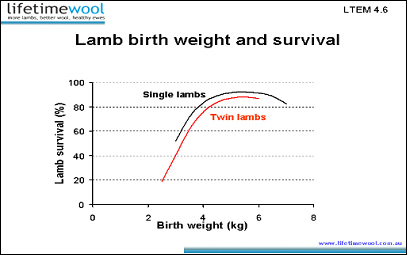
Lamb survival is closely correlated with ewe condition score at lambing and the pasture available to the ewe in the birthing area, table 1.
Table 1: As ewe condition score at lambing increases so does lamb survival percentage.
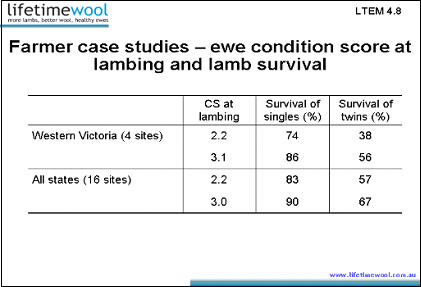
Our objective is for lambing paddock to have a minimum of 3000 kg green dry matter per hectare.
This quantity has two critical impacts. Firstly it provides a micro-climate protection within the 20 cm high pasture for the lambs by preventing wind chill and secondly it ensures the ewe has maximum quantity of high quality pasture to eat before, during and after giving birth. She has no need to wander away from the birth zone to eat sufficient pasture to meet her needs. Ewes will remain in the birth zone for around six to eight hours.
Figure 4A: In the last four weeks of pregnancy (late July – August) ewes on Moffitts Farm have access to pasture containing 2000 – 3000kg green dry matter per hectare. Note the MLA pasture ruler is two rulers taped together, a single ruler is not long enough.
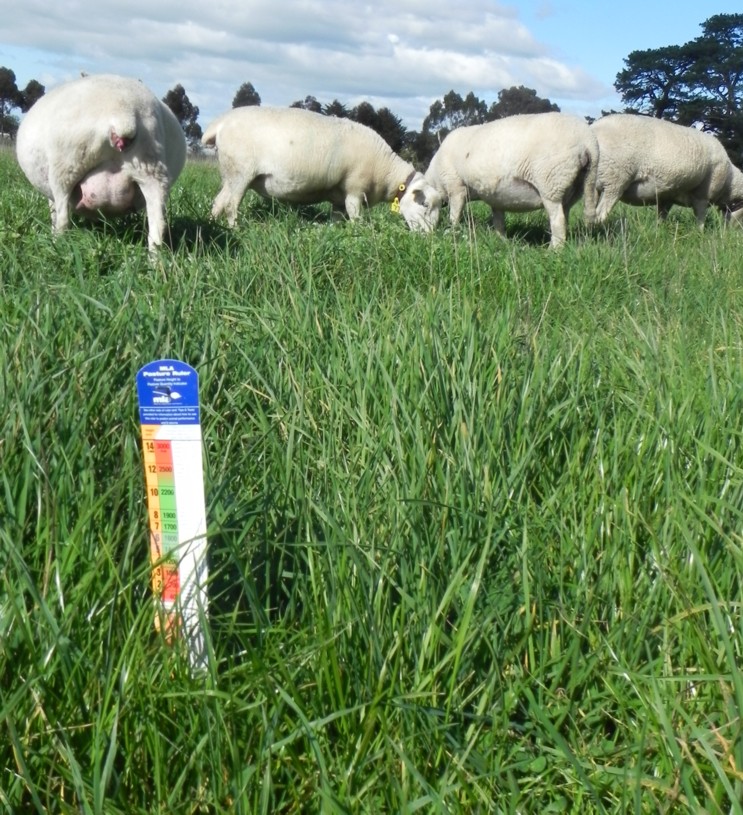
Figure 4B: In lambing paddocks with greater than 3000kg dry matter per hectare, wind chill on lambs is eliminated in the tall pasture.
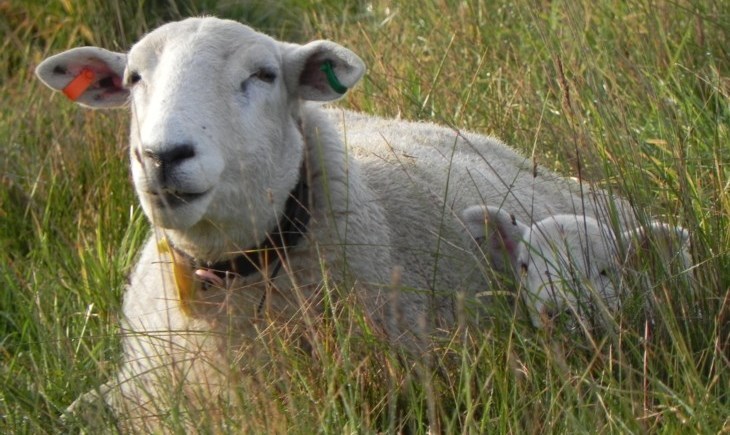
One of the consequences of our approach to ewe nutrition is that we don’t need to pregnancy test to divide ewes into separate flocks based on whether they are carrying a single foetus or multiple foetuses. We provide the entire flock with sufficient high quality pasture during the last six weeks of pregnancy to ensure optimum lamb birth weights and ewe vitality.
Tails left on at lamb marking
One of the key reasons for choosing Wiltipoll sheep for prime lamb production is their ability to shed 100% of their wool. In 2014 we started a trial to find out if leaving tails on lambs would create any management problems. Tails on other breeds are only removed because of management issues mainly associated with shearing and crutching but also with internal parasites which may cause animals to scour and accumulate dags.
After two years we found there was no problem with tails from a management point. The wool sheds off the tail and the animals seem to easily lift their tails to keep them clear of poo. The only negative we know for tails is discrimination in sale yards. As we only sell direct to an abattoir this is not an issue for us.
Figure 5: We are no longer docking tails on our Wiltipoll lambs.

We decided leaving them on is simply recognising that tails are a natural appendage and means eliminating one painful stock husbandry procedure that is no longer required. With no tail docking the impact on behaviour post-marking the males which are castrated using rings is remarkable. We noted that the male rams showed far less physical discomfort activity compared to when they had both tails and scrotums ringed. While our observations are anecdotal, some New Zealand data suggests the discomfort may be significantly reduced by not docking tails.
The 2000 New Zealand Veterinary Journal article (48:2, 33 – 43), “Acute castration and/or tailing distress and its alleviation in lambs” by D.J. Mellor a & K.J. Stafford, compares plasma cortisol concentration responses of 4 – 6 weeks old lambs to tailing plus castration versus castration alone, figure 6. It showed that the lamb castrated with a ring but not tailed had a peak plasma cortisol concentration less than half that of lambs that were tailed and castrated at the same time. In other words the lambs with tail left on were not under the same level of discomfort as those tailed and castrated. This coincides with our visual observations of male lambs behaviour at marking since we stopped the procedure in 2016.
Figure 6: Castrating male lambs with a ring but not tailing them seems to significantly reduce the pain/discomfort incurred as indicated by lower plasma cortisol concentration (right). Source: New Zealand Veterinary Journal 2000 (48:2, 33 – 43).
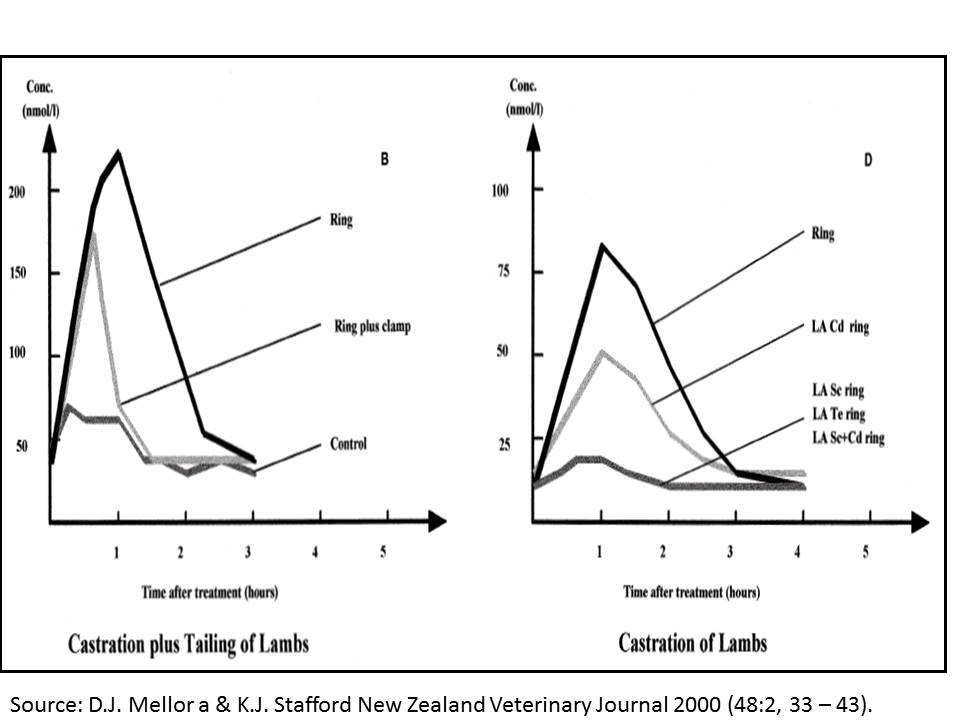
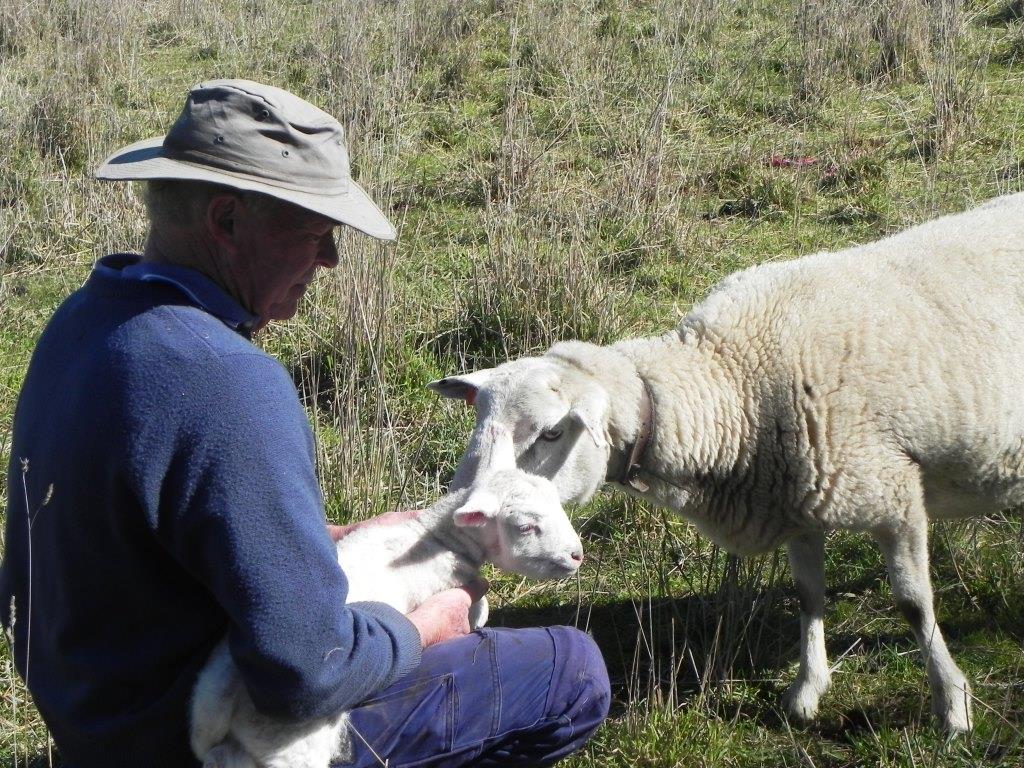

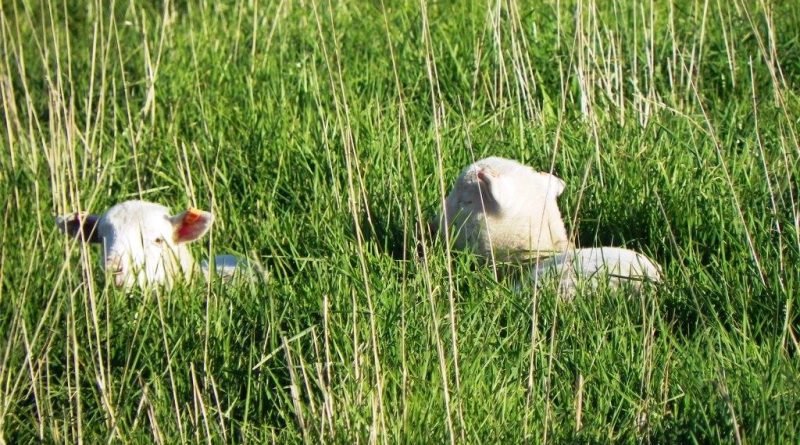
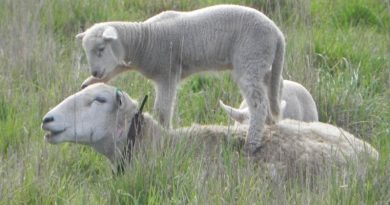
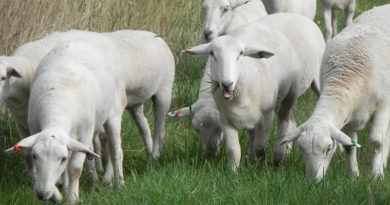
Excellent information, thank you
Hello.I was wondering if you had any Wiltipoll Ewes for sale and prices.Cheers Lorna Murphy
Hello Lorna,
Apologies for the late reply. We will have some August/September 2018 born Wiltipoll ewe lambs for sale in February 2019. While ewe lambs can be joined if they 50kg live weight or heavier at joining, I prefer to join them for the first time at 18 – 20 months of age and fully grown. These commercial (not stud registered) ewe lambs are priced at $200 plus GST and have growth rate data and pedigree available. Also they are identified as twins or singles. Patrick Francis
We have mothers with lambs born July 2017.
Is it safe for mums to be joined again this year 2018? We have been given different advice re lambs. Some say lambs can be left in with their mums and a ram and won’t get pregnant and others say we must separate lambs from their mums and the ram until next year, 2019, when they will be 18 months old. What is your practice please? Thsnkyiu
Hi Heather, it is safe for your ewe mums to be joined again in 2018. Ewe conception rates are correlated with how much live weight the ewes regain after lambing. It’s one of the reasons why we usually wean lambs at 12 to 14 weeks of age. It enables the mums to look after themselves and regain weight without their lamb(s) constantly trying to suckle. Ewes with twins are more at risk of loosing significant amount of weight during lactation and if their lambs stay with them, some can have trouble gaining weight even though lactation peaks about four weeks after lambing then declines. However, if lambs are allowed to stay with their mums they will continue to suckle and if pasture in the paddock is not plentiful will compete for that as well. Putting a ram into a flock of ewes with lambs at foot can be risky if the ewe lambs for most breeds reach about 40kg live weight or more. That live weight will be achieved by around 6 to 8 months of age depending on pasture quantity and quality available and flock genetics (genetic growth rate). At around 40kg live weight ewe lambs reach puberty and begin their oestrus cycles. As age and weight at puberty can be variable, you are taking a considerable risk putting a ram in with ewes which have lambs at foot about this weight. If a light weight ewe lamb does conceive, her ability to grow and provide nutrition for the foetus is limited, so what often happens is the pregnant ewe lamb fails to grow to her mature weight and skeletal size. Her foetus may be too large for her pelvic opening and she will need assistance to deliver the lamb. There is potential to join ewe lambs that are over 45kg and preferably over 50kg live weight at joining. These ewe lambs need top quality nutrition during their pregnancy so they continue to grow body weight and skeleton as well as grow their foetus. If ewe lambs do not reach 45kg at joining and cannot be provided with high quality nutrition during pregnancy, then I would recommend not joining them, let them grow out for another 12 months and join them when 18 to 20 months of age.
Thank you for this information it was a very interesting piece to read especially for a person wanting to enter the wiltipoll sheep breeding market.
Is it necessary to castrate male lambs?
At what age do they need to be separated from flick if left whole.
Thank you
Thanks for the question. Castration is necessary for two reasons: if ram lambs are not castrated they may mate with their siblings once they reach puberty at 40 – 45 kg live weight. The better the lamb nutrition from milk pre-weaning and on pasture post weaning, the quicker male and female lambs reach puberty. Puberty is more weight related than age related. We aim to sell ewe lambs for meat processing at around 45 – 50 kg so mating is potentially possible before they reach this live weight if male lambs were kept entire. We don’t want our ewe meat lambs to become pregnant. The second reason is Australian butchers don’t want to buy entire male lambs as post puberty they can have a male taint in their meat and they have a lower body fat content which can downgrade meat visual quality and eating quality. So for us entire male lambs must be castrated unless some are being kept as future breeders.